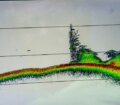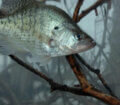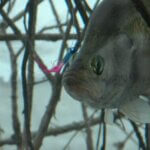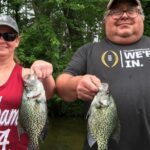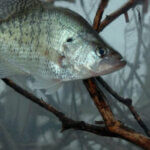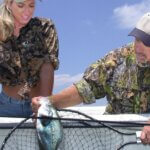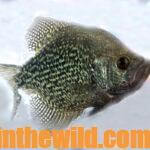Editor’s Note: Your knowledge of warm-weather crappie and having the correct equipment will make you successful fishing in the summer.
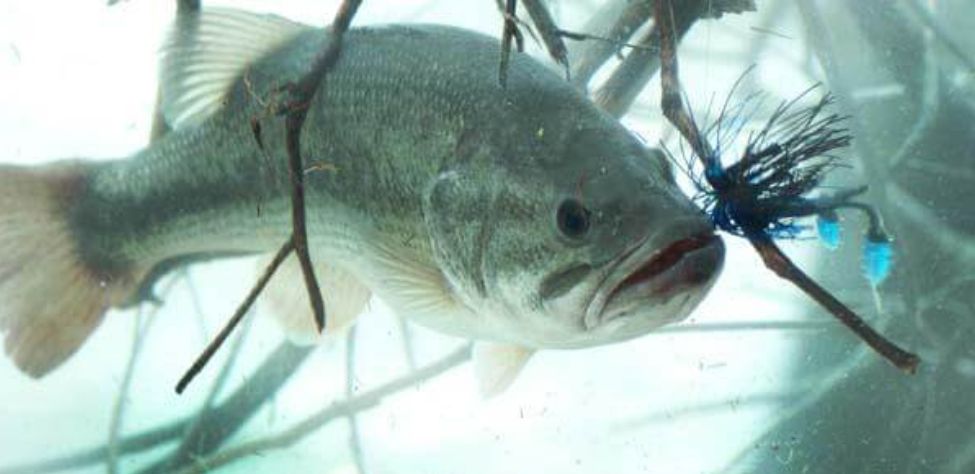
In hot weather, crappie will be more predictable and generally easier to find and catch. But you must understand where to locate them, how they move during the day, what tactics produce the most crappie, and when you should avoid the sun to fish.
To learn the equipment that one of the most-successful crappie fishermen I know, Tony Adams of Eufaula, Alabama (email to: tony.adams@Marvins.com) (334-695-3003), a guide at Lake Eufaula in Eufaula, Alabama, uses, I asked Adams why he chooses the equipment he does for summertime crappie fishing and particularly what baits he fishes.
Eye Hole Jigs with Plastic Grubs
If Adams’ customers want to cast and retrieve jigs, he’ll have them fish Eye Hole Jigs (334-726-9360) (email to: blake@eyeholejig.com) with plastic grubs like Big Bites’ Acid Rain (white, yellow and chartreuse) and Snot Rocket (yellow & white) and Bobby Garland’s Monkey Milk.
According to Adams, “I fish Eye Hole Jigs that allow me to put Crappie Magnets that hold scent in the eye holes of the jigs. Then the scent will remain on the jig much longer than if I put the Crappie Magnet on the hook of the jig. I like the plastic grub on a jig in a color called Acid Rain made by Big Bite Baits Lure Company. These grubs offer three of the most-dominant crappie-catching colors: white, yellow and chartreuse. My favorite color for a jig head is either orange or pink. I fish Crappie Magnets or Slab Bites – both attractants with scent you can put in the Eye Hole Jigs. I like the silver-flake colors.
“I’ll cast the 1/16-ounce Eye Hole jigs with attractant to the cover, get as close to the cover as I can and start slow-swimming the jigs back to my War Eagle boat. I’ll also use these Eye Hole jigs when fishing deep structures in 12-30 feet of water.”
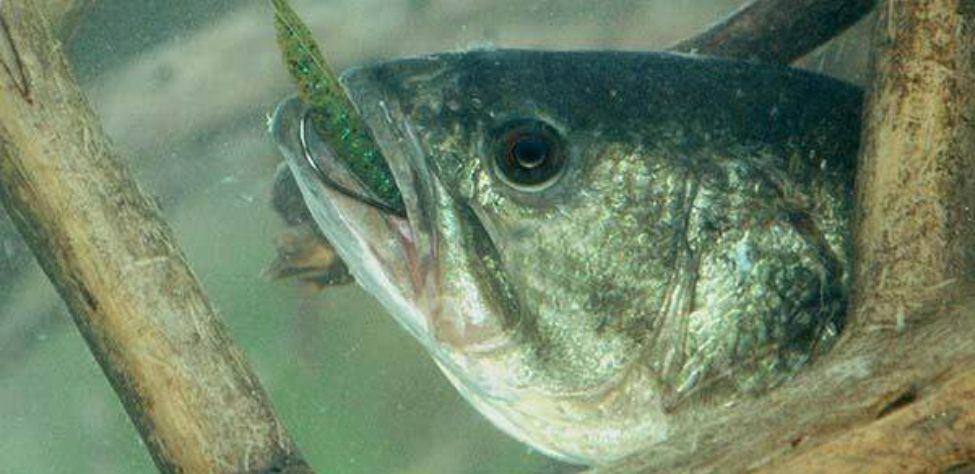
Adams believes that adding scent in the eye hole of the jig seems to encourage the fish to bite more actively. The Eye Hole jig is a relatively-new jig. In the past, when anglers put Crappie Magnets or other forms of scent on their jig hooks, then after catching two or three crappie, that scent dissipated from the hooks. By putting a Crappie Magnet in the eye of the Eye Hole jig, the scent remains on the lure much longer and allows anglers to catch many-more crappie.
“I like a light 1/16-ounce jig when I’m jig fishing for crappie because it has a slower fall than a heavier jig head does,” Adams explains. “Then the crappie has more time to look at the jig before it attacks. If I’m fishing in very-deep water or on windy days, I’ll use a heavier jig head to get the jig down quicker in the deep water.”
Live Minnows
Adams also fishes with live minnows. “Many of my customers like to see their lines jump and the tips of their poles bounce with live minnows. I’ll fish the style of crappie fishing that my customers want to fish to catch crappie. When fishing’s tough, live minnows are hard to beat. Even when we’re fishing jigs, we may tip our hooks with live minnows as well as having a grub on the jig and scent in the Eye Hole jig.”
Tomorrow: Know Depthfinders and Trolling Motors for Crappie
Expert Guidebooks on Crappie Fishing: Best Sellers
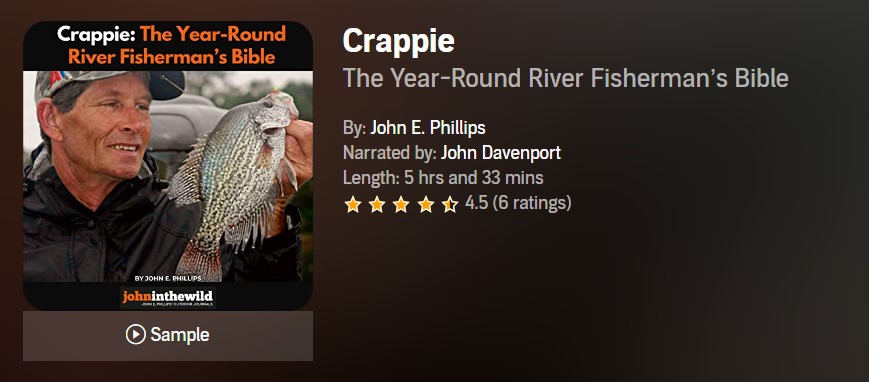
Fishing rivers for crappie and being able to find and catch speckled sides consistently has long been one of the mysteries in the crappie-fishing world.
“One of the reasons that river systems are so difficult to fish is because the water’s either rising or falling in them,” says Ott DeFoe, the 2019 Bassmaster Classic champion.
Rivers also are very susceptible to floods and droughts and constantly have current moving through them. Often fast current or slow current in rivers is created by rain or droughts upstream. When rivers flood, they can wash away fish habitat like logs, sunken trees, manmade brush piles and stake beds. But that’s the time when a river also creates new crappie hot spots that haven’t been available to the crappie or the fishermen before the flood.
Because river systems are so unpredictable, I’ve felt the best way to get the most useful information on how to fish rivers for crappie is to talk to numbers of anglers all over the nation to learn their best tactics.
In this book, I’ve gleaned crappie-fishing wisdom from three dozen crappie anglers and guides from a dozen states, who consistently catch crappie at all times of the year. The tournament crappie fishermen in this book fish most of the country at different times of the year on various river systems and lakes. And, these anglers use techniques you never may have considered, including:
- Setting up a casting ring with your electronics to keep you from getting too close to the crappie that are holding on underwater structure, while you’re fishing all the way around the structure;
- Buying an automotive laser temperature gauge to measure water temperature
- Evaluating the most-productive places to sink brush and other structure, according to prevailing wind direction, the crappie’s summer, fall, winter, and spring migration patterns, and other factors.
VERSIONS: AUDIBLE, KINDLE & PRINT
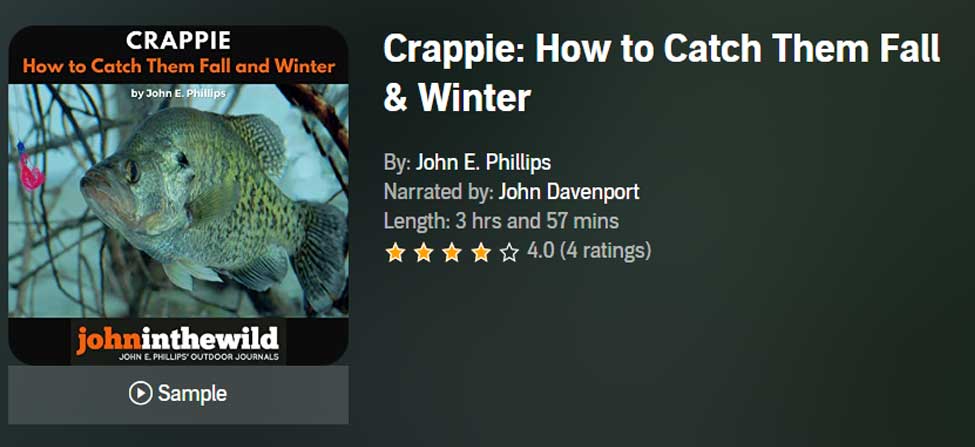
Crappie: How to Catch Them Fall & Winter
Yes, you can catch and eat crappie during the fall and winter months. Often, at many places, you’ll catch more and bigger crappies in the fall and winter than you do in the spring and summer. To learn where to find and how to catch cooler weather speckled sides, we’ve interviewed a wide variety of some of the nation’s best tournament crappie fishermen and guides.
Many of the individuals you’ll hear about in this audiobook are tournament crappie pros who travel the country to fish in crappie tournaments from New York to Florida and from Virginia to California. They use the latest crappie-finding equipment, the best poles, rods, reels, line, and the most-productive baits. Each of the people mentioned in this book has the ability to be dropped out of an airplane anywhere in the United States and catch crappie on any lake close to where they land that contains crappie.
From over 50 years of crappie-fishing experience, I’ve learned that you get the best advice by interviewing a large number of people who have different tactics and fish under various water, weather, and fishing-pressure conditions.
In this book, you will learn:
- How to spider-rig (slow-troll), which is one of the fastest-growing techniques for catching the most and biggest crappies in the shortest time
- How to catch crappie on crank baits and when and where using a crank bait is the most appropriate
- How to find areas of any lake that will hold large schools of crappies during the winter months – places you can return to time and again and expect them to be there
- Why competing in crappie tournaments is one of the quickest ways to learn how to catch more and bigger crappie faster
- Why and how to look for and catch the biggest crappie in a lake
VERSIONS: AUDIBLE, KINDLE & PRINT
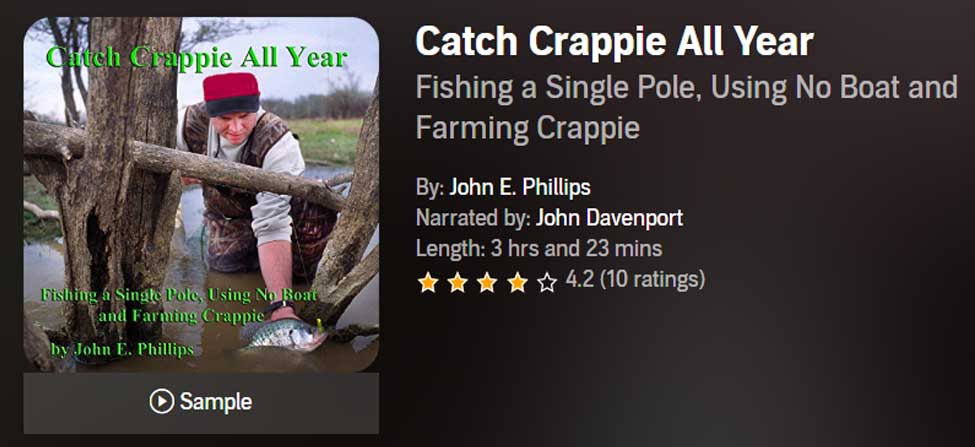
Catch Crappie All Year: Fishing a Single Pole, Using No Boat, and Farming Crappie
I’ve interviewed some of the best crappie fishermen in the nation for my new audiobook, Catch Crappie All Year: Fishing a Single Pole, Using No Boat and Farming Crappie to learn how, where, and when to catch the most crappie with or without a boat while single-pole fishing. I’ve also included information on how to grow a crop of crappie to catch every day of the year. Although I’ve fished in fully rigged crappie boats costing $45,000 – $90,000-plus that can have up to 16 rods at one time to slow troll, I still enjoy….
- Watching a quill cork sink in a brush top
- Fishing with an ultralight spinning rod
- Reeling jigs or minnows along a grass line and feeling that thud when a crappie takes the bait
- Fishing with family and friends, even if we all can’t fit in one boat
- Participating in less-expensive and hassle-free yet highly-productive crappie fishing like single poling
I’ve tried to capture in this new audiobook the old way of crappie fishing with new twists and detailed tactics to aid you in catching crappie all year.
VERSIONS: AUDIBLE, KINDLE & PRINT
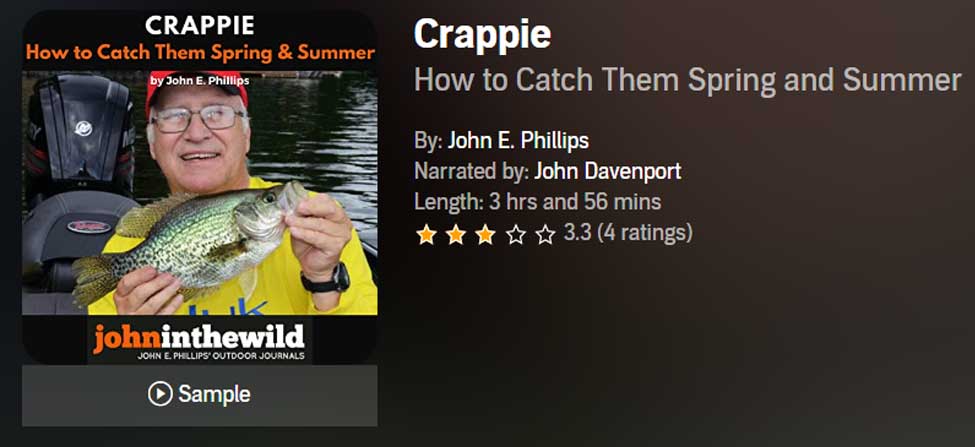
Crappie: How to Catch Them Spring and Summer
You can catch crappie all year long if you know where to find them and what techniques to use to catch them. However, crappie fishing is so technical these days, and we’ve learned so much about how to crappie fish because of the professional crappie-fishing circuits, that one book can’t hold all the information.
This book is the first of a three-part series on how, where, and when to catch crappie, with the best crappie fishermen in the nation. Many of these men have proven they are the best, because they’ve won crappie-fishing tournaments or been successful fishing guides for many years.
This audio version of Crappie: How to Catch Them Spring and Summer includes crappie pros like Ronnie Capps, who has won seven national championships and over $1 million with his partner Steve Coleman.
We also have Malcolm Lane, Stokes McClellan from North Carolina, Billy Blakeley from Reelfoot Lake, John Woods, Kent Driscoll, fishing biologist and professional basser Ken Cook, and many others. We asked the questions that crappie fishermen want answered about how to find and catch crappie during the spring and summer months, and these fishing tips are the result.
In the world of crappie fishing, no one man knows it all, and that’s why I’ve interviewed so many fishermen, asked so many questions, and tried to get so many answers for you about how to fish.
VERSIONS: AUDIBLE, KINDLE & PRINT

